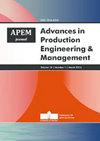Estimating the position and orientation of a mobile robot using neural network framework based on combined square-root cubature Kalman filter and simultaneous localization and mapping
IF 2.8
3区 工程技术
Q2 ENGINEERING, MANUFACTURING
引用次数: 4
Abstract
The real‐time performance of target tracking, detection, and positioning behaves not well for non‐Gaussian and nonlinear model with circumstance uncertainty. The weak observability of the system under large noise causes the algorithm unstable and slow to converge. A new estimation algorithm combining square‐root cubature Kalman filter (SRCKF) with simultaneous localization and mapping (SLAM) is proposed. By connecting neural network weights, network input, functional types and ideal output network, the algo‐ rithm firstly update iteratively the SRCKF‐SLAM state model and observation model, then conduct the cubature point estimate (weights) neural network framework. Thus, a point set better representing the target state and a more accurate state estimation are achieved, which can improve the filtering accu‐ racy. This paper also estimates robot and characteristic states by filtering in groups. The simulation results showed that the proposed algorithm is feasible and effective. Compared with other filtering algorithms such as SRUKF and SRCDKF, it improves the estimation accuracy. Applying the new algorithm to the position filtering estimation of mobile robot can effectively reduce the positioning error, achieve high‐precision tracking detection, and improve the accuracy of robot target detection. © 2020 CPE, University of Maribor. All rights reserved.基于联合平方根立方卡尔曼滤波和同步定位映射的神经网络框架估计移动机器人的位置和姿态
在环境不确定的非高斯和非线性模型下,目标跟踪、检测和定位的实时性不佳。系统在大噪声下的弱观测性导致算法不稳定,收敛速度慢。提出了一种将平方根立方卡尔曼滤波(SRCKF)与同步定位与映射(SLAM)相结合的估计算法。该算法通过连接神经网络权值、网络输入、功能类型和理想输出网络,首先迭代更新SRCKF - SLAM状态模型和观测模型,然后进行培养点估计(权值)神经网络框架。这样可以得到一个更好地表示目标状态的点集和一个更准确的状态估计,从而提高滤波的精度。本文还采用分组滤波的方法对机器人状态和特征状态进行估计。仿真结果表明了该算法的可行性和有效性。与SRUKF、SRCDKF等滤波算法相比,提高了估计精度。将新算法应用于移动机器人的位置滤波估计,可以有效地减小定位误差,实现高精度的跟踪检测,提高机器人目标检测的精度。©2020 CPE,马里博尔大学。版权所有。
本文章由计算机程序翻译,如有差异,请以英文原文为准。
求助全文
约1分钟内获得全文
求助全文
来源期刊

Advances in Production Engineering & Management
ENGINEERING, MANUFACTURINGMATERIALS SCIENC-MATERIALS SCIENCE, MULTIDISCIPLINARY
CiteScore
5.90
自引率
22.20%
发文量
19
期刊介绍:
Advances in Production Engineering & Management (APEM journal) is an interdisciplinary international academic journal published quarterly. The main goal of the APEM journal is to present original, high quality, theoretical and application-oriented research developments in all areas of production engineering and production management to a broad audience of academics and practitioners. In order to bridge the gap between theory and practice, applications based on advanced theory and case studies are particularly welcome. For theoretical papers, their originality and research contributions are the main factors in the evaluation process. General approaches, formalisms, algorithms or techniques should be illustrated with significant applications that demonstrate their applicability to real-world problems. Please note the APEM journal is not intended especially for studying problems in the finance, economics, business, and bank sectors even though the methodology in the paper is quality/project management oriented. Therefore, the papers should include a substantial level of engineering issues in the field of manufacturing engineering.
 求助内容:
求助内容: 应助结果提醒方式:
应助结果提醒方式:


